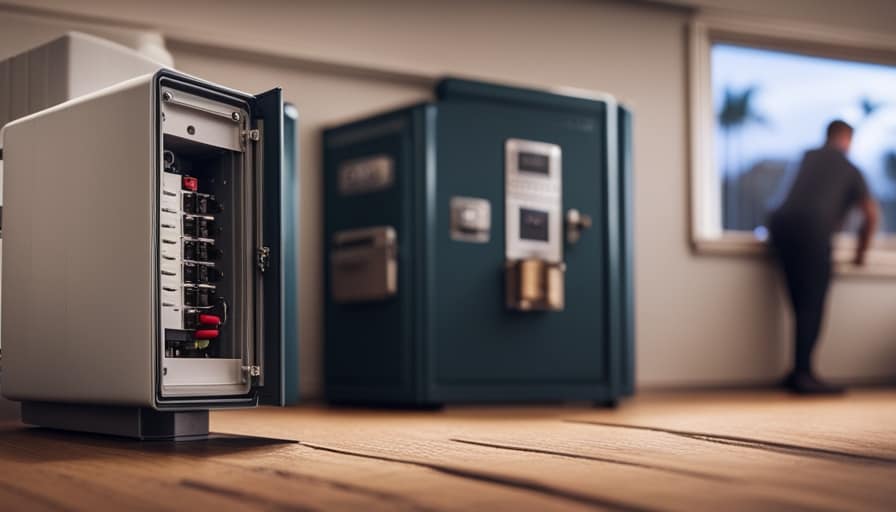As a homeowner, I know how annoying it can be to have small flies flying around your house. But don’t worry! In this article, I will provide tips on how to eliminate these annoying pests for good.
We’ll explore the different types of tiny flies you might encounter, the reasons behind their infestations, and effective natural and chemical solutions. Plus, I’ll give you tips on preventing future fly invasions.
Let’s dive in and reclaim your home from these bothersome creatures.
Key Takeaways
- Identifying common breeding areas and understanding the life cycle of tiny flies are crucial in implementing targeted control measures.
- Natural remedies such as vinegar, baking soda and sugar mixture, essential oils, and DIY flypaper can be effective in repelling flies.
- Chemical insecticides, when used carefully and following instructions, can be effective in eliminating flies.
- Preventing future fly infestations involves installing fly traps, proper food storage, regular disposal of garbage, maintaining cleanliness and hygiene, and using fly swatters and repellent sprays.
Identifying the Types of Tiny Flies in Your House
I often see tiny flies in my house, and it’s important to identify the types of flies to effectively get rid of them.

Understanding the life cycle of these tiny flies can provide valuable insights into their breeding habits and enable us to tackle the infestation at its source.
Tiny flies, such as fruit flies and drain flies, have distinct breeding areas that we should be aware of. Fruit flies, for example, lay their eggs on overripe fruits and vegetables, while drain flies prefer to breed in moist areas like drains and sewage pipes.
By identifying these common breeding areas, we can implement targeted control measures to eliminate the tiny flies and prevent further infestations.
Taking a scientific approach to identifying the types of tiny flies in our house is crucial in serving others by effectively getting rid of these pesky pests.

Understanding the Causes of Tiny Fly Infestations
The presence of tiny flies in the house can be attributed to a variety of factors, including poor sanitation and favorable breeding conditions. Understanding the life cycle of tiny flies is crucial in tackling infestations effectively. These flies typically undergo a complete metamorphosis, starting as eggs, progressing to larvae, then pupae, and finally emerging as adults. The duration of this life cycle can vary depending on the species, but it generally takes about two weeks. To understand where these tiny flies are breeding, it is important to identify their common breeding grounds. Some common breeding grounds for tiny flies include decaying organic matter, such as fruit, vegetables, and garbage, as well as moist areas like drains and damp soil. By addressing these breeding grounds and maintaining proper sanitation, you can significantly reduce the presence of tiny flies in your house.
| Common Breeding Grounds | Examples |
|---|---|
| Decaying organic matter | Fruit, vegetables, garbage |
| Moist areas | Drains, damp soil |
Natural Remedies for Getting Rid of Tiny Flies
To effectively tackle the issue of tiny flies in your house, try using natural remedies such as vinegar and baking soda. These remedies aren’t only safe and environmentally friendly but also effective in repelling and eliminating flies. Here are some natural fly repellents and DIY fly traps that you can try:
-
Vinegar: Mix equal parts of vinegar and water in a spray bottle and use it to wipe down surfaces or spray it in areas where flies are commonly found. The strong smell of vinegar repels flies.
-
Baking soda and sugar: Create a mixture of equal parts baking soda and sugar and place it in a shallow dish. The sweet scent of sugar will attract the flies, while the baking soda will kill them when they consume it.

-
Essential oils: Certain essential oils like lavender, eucalyptus, and peppermint are known to repel flies. Add a few drops of these oils to a spray bottle filled with water and spray it around your home.
-
Flypaper: Make your own flypaper by coating strips of paper or cardboard with a sticky substance like honey or syrup. Hang them in areas where flies are present, and they’ll get stuck to the paper.
Chemical Solutions for Eliminating Tiny Flies
Using chemical insecticides is an effective and convenient way to eliminate tiny flies in your house. When it comes to pest control, insecticides play a crucial role in eradicating these pesky insects. There are various types of insecticides available on the market, such as sprays, foggers, and baits, each designed to target and eliminate flies effectively. It’s important to choose insecticides specifically formulated for flies to maximize their efficacy.
When using chemical insecticides, it’s crucial to follow the instructions carefully, including wearing protective gear and ensuring proper ventilation. While chemical solutions can be highly effective, it’s important to note that they may contain potentially harmful substances, so caution should be exercised.

Transitioning into the next section, preventing future tiny fly infestations in your house is equally important to maintain a fly-free environment.
Preventing Future Tiny Fly Infestations in Your House
I can take several proactive steps to prevent future tiny fly infestations in my house. Here are some effective methods to consider:
-
Install fly traps: Placing fly traps in strategic locations can capture adult flies and prevent them from laying eggs. Sticky traps and UV light traps are popular options that effectively attract and trap flies.
-
Practice proper food storage: Tiny flies are often attracted to decaying food and organic waste. To discourage their presence, store food in airtight containers and dispose of garbage regularly. Additionally, clean up spills and crumbs promptly to eliminate potential food sources.

-
Maintain cleanliness: Regularly clean and sanitize your kitchen and other areas prone to flies. Pay special attention to drains, as tiny flies often breed in moist areas. Using drain cleaners and covering drains with mesh can help prevent flies from breeding.
-
Seal entry points: Inspect your home for any gaps or cracks that flies could use to enter. Seal these entry points with caulk or weatherstripping to prevent flies from infiltrating your living space.
Frequently Asked Questions
What Are Some Common Signs of a Tiny Fly Infestation in Your House?
Some common signs of a tiny fly infestation in your house include seeing a large number of flies, finding their eggs or larvae, and noticing a strong, unpleasant odor.
Can Tiny Flies Transmit Diseases to Humans?
Yes, tiny flies can transmit diseases to humans. Some potential health risks associated with a tiny fly infestation in your house include food contamination and the spread of bacteria like E.coli and Salmonella.

How Long Does It Usually Take to Get Rid of Tiny Flies Using Natural Remedies?
When trying to get rid of tiny flies in your house, it’s important to consider the long-term effectiveness of natural remedies. Alternative methods can be used, but their success may vary.
Are Chemical Solutions Safe to Use Around Children and Pets?
Yes, natural remedies can be effective in getting rid of tiny flies. Some non-chemical alternatives to control them include keeping surfaces clean, removing sources of food and water, and using fly traps.
What Are Some Long-Term Preventive Measures to Keep Tiny Flies From Returning to Your House?
Preventive measures are key to keeping tiny flies from returning. Effective solutions include proper sanitation, sealing entry points, and eliminating breeding sites. Regular cleaning, storing food properly, and maintaining a clean environment are essential.
Conclusion
In conclusion, tiny flies in your house can be a pesky nuisance. Identifying the types of flies and understanding the causes of infestations is crucial in finding effective solutions.

While natural remedies such as vinegar traps and essential oils can help get rid of them, using chemical solutions like insecticides may be necessary for severe infestations.
To prevent future fly problems, maintaining cleanliness, sealing food containers, and fixing any potential entry points are essential.
Remember, a fly-free home is a happy home!
I’m Theodore, and I love tiny houses. In fact, I’m the author of Tiny House 43, a book about tiny houses that are also tree houses. I think they’re magical places where imaginations can run wild and adventures are just waiting to happen.
While tree houses are often associated with childhood, they can be the perfect adult retreat. They offer a cozy space to relax and unwind, surrounded by nature. And since they’re typically built on stilts or raised platforms, they offer stunning views that traditional homes simply can’t match.
If you’re looking for a unique and romantic getaway, a tree house tiny house might just be the perfect option.










